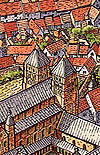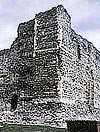![]() Canterbury
Canterbury

 The
city which submitted to William the Conqueror in 1066, shortly after his victory
at Hastings, already had a long and eventful history. Once the Roman regional
capital of Durovernum Cantiacorum, its 3rd century walls still stood
at the time of the Norman conquest. Within them, giving Canterbury its unique
status in the English kingdom, stood the church originally founded by St Augustine
at the time of his Christianising mission to England in the year 597. Outside
the walls, a short way to the east, was the Abbey of St Peter and St Paul,
founded by Augustine as a burial place for members of the Kentish Royal House
and Archbishops. The Normans controlled Canterbury
by means of a motte and bailey castle built astride the city wall in the south-eastern
part of the town; the motte, now forming part of a public garden known as
Dane John (a corruption of the Norman French "Donjon") can still
be seen. The motte and bailey was replaced in c.1089 by a new Royal castle
built just inside the Worth (south) gate, which had a stone keep built in
c.1095, of which a part survives, within a walled bailey.
The
city which submitted to William the Conqueror in 1066, shortly after his victory
at Hastings, already had a long and eventful history. Once the Roman regional
capital of Durovernum Cantiacorum, its 3rd century walls still stood
at the time of the Norman conquest. Within them, giving Canterbury its unique
status in the English kingdom, stood the church originally founded by St Augustine
at the time of his Christianising mission to England in the year 597. Outside
the walls, a short way to the east, was the Abbey of St Peter and St Paul,
founded by Augustine as a burial place for members of the Kentish Royal House
and Archbishops. The Normans controlled Canterbury
by means of a motte and bailey castle built astride the city wall in the south-eastern
part of the town; the motte, now forming part of a public garden known as
Dane John (a corruption of the Norman French "Donjon") can still
be seen. The motte and bailey was replaced in c.1089 by a new Royal castle
built just inside the Worth (south) gate, which had a stone keep built in
c.1095, of which a part survives, within a walled bailey.
Domesday Book (1086) records 187 urban properties and 451 burgesses in Canterbury, and on this basis it has been estimated that the population was about 6000. Other documents, including copious records of the rents on land owned by the cathedral, combine with archaeological excavation and the study of surviving buildings to provide a more detailed picture of Canterbury than of any other town in Norman England.
 Throughout
the Norman period, from the time of Archbishop Lanfranc's appointment in 1070
onwards, the fortunes of Canterbury's citizens benefited from the expansion
of the city's ecclesiastical establishments and the foundation of new ones.
In the first instance, Lanfranc rebuilt the cathedral and cathedral priory
on a grand scale. In addition, he built for himself a new Palace, demolishing
28 houses in the process (according to Domesday Book). Reconstruction of Lanfranc's
church took place in the1130s under Archbishop Anselm and there was further
work in the 1160s under Prior Wibert from whose time comes a famous map of
the cathedral waterworks. Outside the city, to the east, St Augustine's abbey
was rebuilt following the appointment of Abbot Scotland by Lanfranc in 1070
and in 1091 the remains of Augustine and his successors together with those
of St Mildred were moved to new shrines around its high altar. In the south
west suburbs of the city by c.1086, a nunnery, St Sepulchre's, was founded.
Outside the city to the north Lanfranc founded the Priory of St Gregory and,
on the opposite side of Northgate, St John's Hospital (c. 1083-5). Parts of
a chapel, a great double dormitory for men and women, and one of the latrines
complete with its original drain survive. Another hospital, in this case within
the walls, was that of St Thomas on East Bridge founded c.1180, the date of
its surviving hall and undercroft.
Throughout
the Norman period, from the time of Archbishop Lanfranc's appointment in 1070
onwards, the fortunes of Canterbury's citizens benefited from the expansion
of the city's ecclesiastical establishments and the foundation of new ones.
In the first instance, Lanfranc rebuilt the cathedral and cathedral priory
on a grand scale. In addition, he built for himself a new Palace, demolishing
28 houses in the process (according to Domesday Book). Reconstruction of Lanfranc's
church took place in the1130s under Archbishop Anselm and there was further
work in the 1160s under Prior Wibert from whose time comes a famous map of
the cathedral waterworks. Outside the city, to the east, St Augustine's abbey
was rebuilt following the appointment of Abbot Scotland by Lanfranc in 1070
and in 1091 the remains of Augustine and his successors together with those
of St Mildred were moved to new shrines around its high altar. In the south
west suburbs of the city by c.1086, a nunnery, St Sepulchre's, was founded.
Outside the city to the north Lanfranc founded the Priory of St Gregory and,
on the opposite side of Northgate, St John's Hospital (c. 1083-5). Parts of
a chapel, a great double dormitory for men and women, and one of the latrines
complete with its original drain survive. Another hospital, in this case within
the walls, was that of St Thomas on East Bridge founded c.1180, the date of
its surviving hall and undercroft.
 It
is not clear how many parish churches existed in Canterbury before the Norman
Conquest, but by 1200 there were 22, a number which is evidence in itself
for growing population and rising prosperity. Another indication of the latter
was the number of stone houses, of which over 30 are known. Documentary evidence
tells us of the city's markets and mills, of over 200 shops and a thriving
Jewish quarter. The principal commercial area of the town was centred on High
Street, the main south- east to north- west aligned street south of the cathedral
precinct.
It
is not clear how many parish churches existed in Canterbury before the Norman
Conquest, but by 1200 there were 22, a number which is evidence in itself
for growing population and rising prosperity. Another indication of the latter
was the number of stone houses, of which over 30 are known. Documentary evidence
tells us of the city's markets and mills, of over 200 shops and a thriving
Jewish quarter. The principal commercial area of the town was centred on High
Street, the main south- east to north- west aligned street south of the cathedral
precinct.
The prestige and wealth of Canterbury received a considerable boost in the years following the murder of Archbishop Thomas Becket in 1170. Miracles soon began to occur at his grave and the cathedral became a great centre of pilgrimage. Following a fire in 1174 the cathedral was rebuilt and extended to create a magnificent setting for the martyr's tomb.